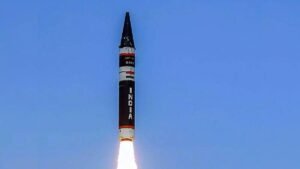
Why in news?
- India’s recent successful test of the Agni-Prime missile marks a significant leap forward in the nation’s strategic defense capabilities.
- This new addition to the Agni class of missiles not only enhances India’s deterrence posture but also underscores its commitment to achieving self-reliance in ballistic missile technology.
Agni-Prime Missile: Advancing Strategic Capabilities
- Overview:
- The Agni-Prime missile represents a cutting-edge advancement in India’s ballistic missile arsenal. As a nuclear-capable, advanced variant within the Agni series, it is designed to meet the evolving challenges of modern warfare.
- Technical Specifications:
- The Agni-Prime is characterized by its two-stage, canisterized system, which ensures rapid deployment and increased resilience to environmental factors.
- With a range spanning from 1,000 to 2,000 kilometers, it possesses the capability to deliver payloads with remarkable precision, bolstering India’s strategic deterrence capabilities.
- Deployment:
- One of the key strengths of the Agni-Prime lies in its versatility of deployment.
- The missile can be launched from various platforms, including aircraft, ships, submarines, and land-based vehicles.
- This flexibility in deployment options enhances the agility and effectiveness of India’s strategic defense posture, allowing for a swift and adaptive response to potential threats.
Integrated Guided-Missile Development Programme (IGMDP):
- Genesis:
- The Agni-Prime missile is a testament to the success of India’s Integrated Guided-Missile Development Programme (IGMDP).
- Conceived by the visionary Dr. A.P.J. Abdul Kalam, the IGMDP aimed to achieve self-sufficiency in missile technology and has yielded several critical missile systems over the years.
- The P-A-T-N-A Missiles:
- Under the IGMDP, India developed a range of missile systems, each serving a specific purpose in the country’s defense strategy:
- Prithvi:
- Prithvi was the first missile to be developed under the program.
- DRDO attempted to build a surface-to-air missile under Project Devil.
- Variants make use of either liquid or both liquid and solid fuels.
- Developed as a battlefield missile, it could carry a nuclear warhead in its role as a tactical nuclear weapon.
- Agni:
- The Agni missile is a family of medium to intercontinental range ballistic missiles developed by India, named after one of the five elements of nature.
- Agni missiles are long-range, nuclear weapons capable, surface-to-surface ballistic missiles.
- Trishul: Trishul is a low-level quick-reaction short range surface-to-air missile developed in India by Defence Research and Development Organisation (DRDO) as part of the Integrated Guided Missile Development Programme (IGMDP).
- Nag:
- The Nag missile also called “Prospina” for the land-attack version, is an Indian third-generation, all-weather, fire-and-forget, lock-on after launch, anti-tank guided missile (ATGM) with an operational range of 500 m to 20 km depending on variant.
- Akash:
- Akash is a medium-range mobile surface-to-air missile (SAM) system developed by the Defence Research and Development Organisation (DRDO) and produced by Bharat Dynamics Limited (BDL).
Defence Research & Development Organisation (DRDO):
- Role and Vision:
- The Defence Research & Development Organisation (DRDO) plays a pivotal role in India’s defense ecosystem, serving as the primary research and development agency under the Ministry of Defence.
- Its vision is to empower India with state-of-the-art defense technologies and capabilities.
- Historical Context:
- Since its establishment in 1958, the DRDO has been at the forefront of advancing India’s defense capabilities.
- It has spearheaded numerous successful projects and collaborations, contributing significantly to the country’s strategic successes and technological advancements.
Conclusion:
- The development and successful testing of the Agni-Prime missile signify a monumental achievement for India’s defense establishment.
- This technological milestone not only strengthens the nation’s security architecture but also underscores its commitment to self-reliance and indigenous innovation in ballistic missile technology.
- As India continues to assert itself as a formidable player on the global stage, the Agni-Prime stands as a symbol of its technological prowess and strategic autonomy in an increasingly complex geopolitical landscape.
People also ask
Q1: What is the Agni-Prime missile?
Ans: The Agni-Prime missile is a new generation ballistic missile developed by India as part of its strategic defense capabilities.
Q2: What distinguishes the Agni-Prime from previous Agni missiles?
Ans: The Agni-Prime represents an advancement in technology with improved range, precision, and versatility compared to earlier variants in the Agni series.
Q3: What are the technical specifications of the Agni-Prime missile?
Ans: The Agni-Prime is a two-stage, canisterized missile with a range of 1,000 to 2,000 kilometers. It is nuclear-capable and designed for quick deployment and high precision targeting.